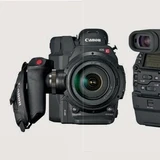Burning Cold

Extreme cold hardens even the softest, most flexible materials and turns even the most solid ones fragile.
Freezing cold is one of the extreme environments that LEMO solutions are able to confront and dominate, as a result of a long experience. Used in a large variety of applications, LEMO solutions can cope with all sorts of constraints, whether they are mechanical, electrical, climatic, natural or artificially produced. Extreme temperatures are part of these critical environments as they expose connectors to very specific stress and strain, which can be severe.
“There’s no normal temperature limit that our connectors can withstand, whether it is above or below zero” notes Billy Barbey, R&D and New Products manager. It goes from
-250 to 300 °C! There is only one thing that is not possible: to move the same connector from one extreme to another within a few seconds. Luckily, in reality no equipment is ever exposed to such a treatment. Even if some customers dream about such a miraculous connector…”
What exactly does it entail to develop connectors resisting temperatures well below zero? “We equip satellites, supply NASA or the European Space Agency, so we have to create connectors that function perfectly in environments where -60°C is still a comfortable temperature!”
Space is indeed quite far away. “Our customers prefer to avoid going all the way up there to replace a part !” jokes the engineer.
The same principle applies as everywhere else: the more demanding maintenance is, the more reliable components have to be. This is also valid for connectors that are used in weather stations located in the Polar Regions, for example. They not only have to be resistant, but they also have to keep their properties unaltered almost for ever.
Before arriving at the North Pole or into space, all LEMO connectors must pass through even more extreme terrain: LEMO’s walls. Their adventure starts invariably in the R&D office, where, based on the technical requirements received from the customer, the concept is developed and the best possible materials are selected. A prototype or a preseries product is then produced and submitted to LEMO’s test laboratory in Ecublens (Switzerland), headed by Roger Vonlanthen for almost 30 years. A professional torture chamber for connectors, this laboratory has been developed to inflict all possible forms of ill-treatment to them. Even the impossible ones. More than fifty features can be evaluated based on as many different tests.
Cold tests are part of the “environmental tests”, a series of specific tests that help define the operating conditions and limits, for transporting or storing connectors.
The connector is placed in a climatic chamber and exposed to very low temperatures, sometimes for several days. The R&D laboratory has a number of these chambers with temperatures as low as -70°C. Once taken out of the chamber, the connector is thoroughly examined: it is submitted to mechanical, electrical and visual tests. All its components are verified.
Microscopes often confirm a technological truth: the most vulnerable elements of a connector exposed to hot or cold temperatures are its synthetic parts. Insulators and epoxy resins for example, used in the rear part of sockets, may have fissures invisible to the naked eye. When damaged, these synthetic elements may compromise the sealing integrity of the connector. In case of fissures, the engineers get back to work, until they perfectly control all of the components.
It is not only the lack of resistance to extreme cold that is eliminatory. LEMO systematically eliminates synthetic elements (materials, glues, resins…) that do not comply with strict environmental standards. Even if their resistance to extreme cold is excellent.
Thanks to the precision of these tests and measurements and also to the perfect control of its products and processes, today LEMO has a large base of verified solutions that can meet new demands. Still, as part of technological monitoring, LEMO continues to study new materials to further improve the performance of its connectors.
This extensive experience is coupled with the deep understanding of customer needs. Civil aviation standards are often the same as the ones that apply to military applications, so products are similar or identical. A well conceived application for an operating theatre may well also end up as part of a race car…
For extreme cold applications, it is products developed for cryogenics that are used as a reference. An example shows very well how important this adaptability is. “For medical applications, we tested the resistance of an FFA.00.250 plug immersed in -260°C, tells Roger Vonlan- then. In fact, it had to equip a system capable of measuring the temperature of liquid helium in which test tubes containing biological material are stored. Thanks to our experience and tried and tested technologies, we are able to propose reliable solutions in all fields.”
As for the FFA.00.250 plug, it keeps its cool about all these human considerations. It only dreams about all the outer reaches of our galaxy that it will be able to explore with no difficulty whatsoever.



